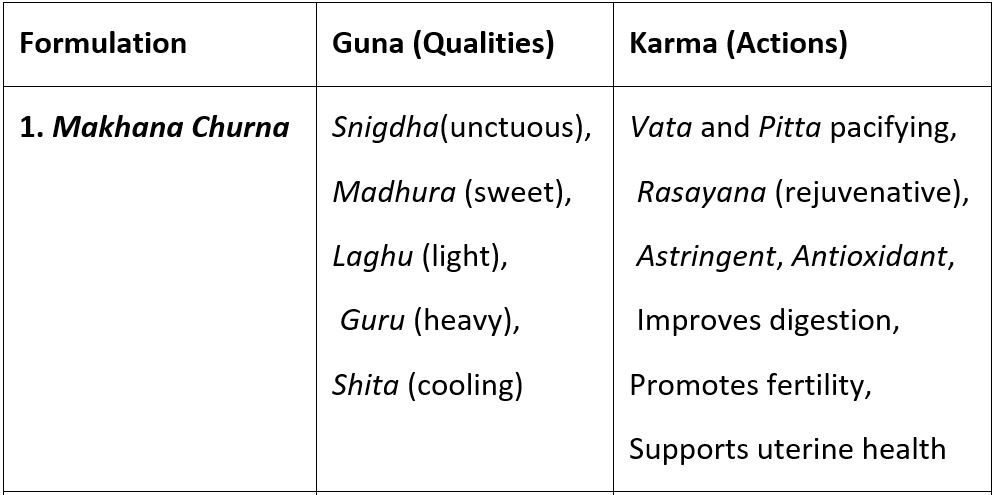Therapeutic Potential of Makhana Churna and Sharkarayukta Dugdha: An Ayurvedic Perspective
DOI:
https://doi.org/10.21760/jaims.10.5.29Keywords:
Intrauterine Growth, Makhana Churna, Sharkarayukta Dugdha, Garbha Vriddhi, Rasayana Therapy, Maternal NutritionAbstract
The foundation of lifelong health is established during the intrauterine period, where proper fetal growth and development are crucial determinants of future well-being. Ayurveda, the ancient science of life, emphasizes the critical importance of Garbha Vriddhi (fetal development) and prescribes specific dietary and lifestyle guidelines under Garbhini Paricharya (antenatal care) to ensure healthy offspring. Rasayana (rejuvenative) and Brimhana (nourishing) therapies form the cornerstone of intrauterine health maintenance. Among the various Rasayana Dravyas mentioned in Ayurvedic texts, Makhana (Euryale ferox Salisb.), known for its Madhura Rasa, Guru and Snigdha Guna, holds significant importance for promoting Dhatu Poshan (tissue nourishment) and enhancing vitality. Sharkarayukta Dugdha, a classical combination of sweetened milk, is recommended for pregnant women to nourish the fetus, enhance maternal Ojas, and ensure smooth parturition. The synergistic use of Makhana Churna (powdered Makhana) with Sharkarayukta Dugdha provides an excellent dietary intervention aimed at improving intrauterine nutrition, preventing low birth weight, and supporting healthy tissue development. Modern scientific studies have also highlighted Makhana’s high protein, calcium, antioxidant, and micronutrient content, making it beneficial for maternal health and fetal growth. Similarly, milk’s easily digestible proteins and Sharkara’s energy-enhancing properties contribute to meeting the increased metabolic demands of pregnancy. This article critically explores the Ayurvedic rationale and modern nutritional relevance of using Makhana Churna with Sharkarayukta Dugdha during pregnancy, aiming to present a holistic approach for promoting optimal intrauterine development, enhancing maternal health, and preventing fetal growth disorders through natural, time-tested interventions.
Downloads
References
Sushruta. Sushruta Samhita (English translation). Vol. 1. Sharma KK, editor. Varanasi: Chaukhambha Vishwabharati Academy; 2001.
Charaka. Charaka Samhita (commentary by Chakrapanidatta). Varanasi: Chaukhambha Sanskrit Sansthan; 2011.
Tripathi I. Chakradatta (commentary). Delhi: Chaukhambha Sanskrit Pratishthan; 2010.
Sharma PV. Dravyaguna Vijnana. Vol. 2. Varanasi: Chaukhambha Bharati Academy; 2005.
Singh S, Bais S, Bains A. Nutritional and therapeutic applications of Makhana (Euryale ferox Salisb.): A review. Int J Pharm Sci Res. 2020;11(5).
Dwivedi R, Dwivedi S. Milk and milk products: An Ayurvedic overview. AYU. 2007;28(3).
Ghosh S, Mitra S, Paul R. Dietary supplementation during pregnancy: Modern view with traditional perspectives. J Nutr Food Sci. 2018;8(2).
Tiwari PV. Ayurvediya Prasuti Tantra evam Stri Roga. Varanasi: Chaukhambha Orientalia; 2017.
Rao KS. Garbha Sanskara: The Ayurvedic guide to fetal development. Delhi: Chaukhambha Sanskrit Pratishthan; 2003.
Acharya YT. Charaka Samhita with Ayurvedadipika commentary of Chakrapanidatta. Varanasi: Chaukhambha Surabharati Prakashan; 2014.
Tiwari P. Ayurvedic concepts of Garbha and Garbhini Chikitsa. Varanasi: Chaukhambha Bharati Academy; 1991.
Sharma S. Kashyapa Samhita. Varanasi: Chaukhambha Sanskrit Series Office; 2015.
Sharma RK, Dash B. Agni and the mechanism of digestion and metabolism in Ayurveda. Varanasi: Chaukhambha Publishers; 2012.
Srikanthamurthy KR. Bhavaprakasha of Bhavamisra. Vol. 1. Varanasi: Chaukhambha Krishnadas Academy; 2012.
Tiwari PV. Ayurvediya Prasuti Tantra evam Stri Roga. Varanasi: Chaukhambha Orientalia; 2017.
Acharya YT. Charaka Samhita with Ayurvedadipika commentary of Chakrapanidatta. Varanasi: Chaukhambha Surabharati Prakashan; 2014.
Sharma S. Kashyapa Samhita. Varanasi: Chaukhambha Sanskrit Series Office; 2015.
Srikanthamurthy KR. Bhavaprakasha of Bhavamisra. Vol. 1. Varanasi: Chaukhambha Krishnadas Academy; 2012.
Patanjali S. Yoga Sutra. Varanasi: Chaukhambha Sanskrita Series; 2011.
Kapoor S. Postpartum care and rejuvenation in Ayurveda. Pune: Ayurvedic Institute of Wellness; 2019.
Deshmukh A. Postpartum rejuvenation: Ayurvedic approaches for new mothers. Nagpur: Vaidya Ayurveda Press; 2017.
Pandit M. Ayurvedic practices in postnatal care. Mumbai: Vaidya Publications; 2020.















